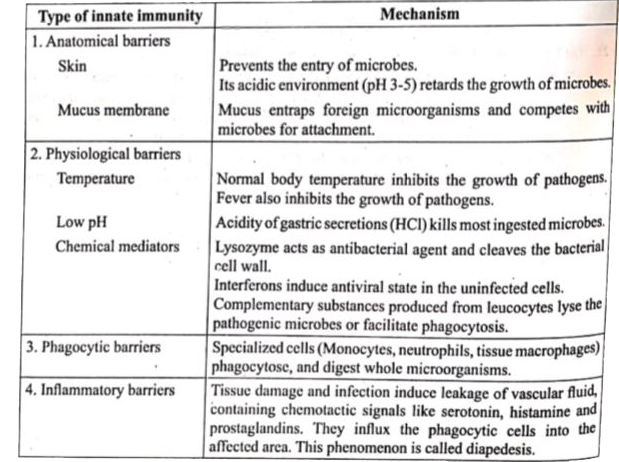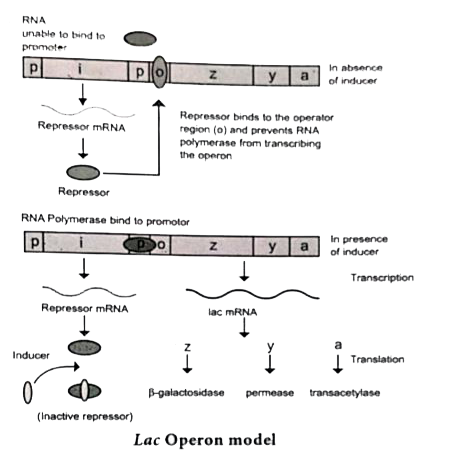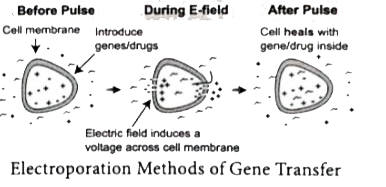InterviewSolution
This section includes InterviewSolutions, each offering curated multiple-choice questions to sharpen your knowledge and support exam preparation. Choose a topic below to get started.
| 20651. |
Question : Bacterial cell wall is mainly composed of____________. |
|
Answer» |
|
| 20652. |
Question : Bacteria used as biogas fermenters are |
|
Answer» halophites |
|
| 20653. |
Question : Bacteria that convert milk into curd play two other beneficial roles. What are they? |
|
Answer» Solution :i. Lactic acid bacteria (LAB) improve NUTRITIONAL quality by increasing vitamin `B_(12)`. II. LAB play a very beneficial ROLE in checking DISEASE causing microbes. |
|
| 20654. |
Question : Bacteria that convert milk into curd play two other beneficial roles? What are they? |
| Answer» Solution :INCREASE in nutritional quality/Vitamin `B_(12)` CHECKS disease-causing microbes in the STOMACH. | |
| 20655. |
Question : Bacteria protect themselves from viruses by fragmentating viral DNA with |
|
Answer» Endonuclease |
|
| 20656. |
Question : Bacteria live in the body of the host , in which bacteria is benefitted and host is not affected, the bacteria is |
|
Answer» Symbiont |
|
| 20657. |
Question : Bacteria involved in two -step conversion of ammonia into nitrate are |
|
Answer» AZOTOBACTER and Nitrosomonas |
|
| 20658. |
Question : Bacteria genetically engineered to express a gene from a plant will |
|
Answer» synthesis a protein with the same sequence of amino acids as in the plant and, therefore, the protein will have the same structure and function as in the plant This functional mRNA is then expressed into proteins. Prokaryotes lack such machinery, hence expression of a eukaryotic DNA becomes difficult in prokaryotic cells. Therefore, scientists prepare CDNA from the functional mRNA (without introns) using reverse transcriptase. This DNA is incorporated into bacteria (or another prokaryotic cell) for expression of plant gene. such foreign gene synthesises a protein with the same sequence if amino acids as in the plant, and therefore the proteins have the same structure and function as in the plant. |
|
| 20659. |
Question : Bacteria commonly used for transferring foreign DNA to crop plants ? |
|
Answer» PENICILLIUM expansum |
|
| 20660. |
Question : Bacteria , fungi and lower plants survive during adverse conditions by |
|
Answer» SUSPENDED growth |
|
| 20661. |
Question : Bacteria cannot be seen with the naked eyes, but these can be seen with the help of a microscope. If you have to carry a sample from your home to your biology laboratory to demonstrate the presence of microbes under a microscope, which sample would you carry and why? |
| Answer» Solution :CURD. It is simple to carry and EASILY DEMONSTRATE the presence of lactobacillus bacteria. | |
| 20662. |
Question : Bacteria cannot be seen with the naked eye but these can be seen with the help of microscope. If you have to carry a sample from your home to your biology laboratory to demonstrate the presence of microbes under a microscope, which sample would you carry and why? |
| Answer» Solution :Curd, because it contains BACTERIUM Lactobacillus ACIDOPHILUS and it is EASILY AVAILABLE. | |
| 20663. |
Question : Bacteria cannot be seen with naked eyes, but these can be seen with the help of a microscope. If you have to carry a sample from your home to your biology laboratory to demonstrate the presence of microbes with the help of a microscope, which sample would you carry and why? |
| Answer» SOLUTION :A sample of curd can be taken as there are Lactic acid bacteria in LAKHS of AMOUNT which can be seen with the help of microscope. | |
| 20664. |
Question : Bacilus thuringiensis produces insecticidal proteins. Why does this protein not kill the Bacilus? |
|
Answer» |
|
| 20665. |
Question : Back cross is used for determining |
|
Answer» PURITY of GAMETS |
|
| 20666. |
Question : Bacillus thuringiensis(Bt strains) have been used for designing novel |
|
Answer» Bio-metallugical techniques |
|
| 20667. |
Question : Bacillus thuringiensis makes our environment pepticide free. Comment. |
| Answer» Solution :BACILLUS thuringiensis produces a toxin called Bt toxin, Gene for Bt toxin has been cloned from bacteria and been expressed in plants to provide resistance to pests. In this manner MANY plants are produced. So in FUTURE this MAKES our environment pesticide free. | |
| 20668. |
Question : Bacillus thuringiensis is used as |
|
Answer» Biofungicide |
|
| 20669. |
Question : Bacillus thuringiensis is a biocontrol agent introduced to control |
|
Answer» Rodents |
|
| 20670. |
Question : Bacillus thuringiensis forms protein crystals which contain insectidical protein. This protein |
|
Answer» binds with EPITHELIAL CELLS of midgut of the insect pest ultimately killing it |
|
| 20671. |
Question : Bacillus thuringiensis forms protein crystals which contain insecticidal protein. This protein |
|
Answer» binds with epithelial cells of midgut of the insect pest ultimately KILLING it |
|
| 20672. |
Question :Bacillus thuringiensis (Bt) strains have been used for designing novel |
|
Answer» bio-metallurgical technique |
|
| 20673. |
Question : Bacillus thuringiensis (Bt) strains have been used for designing novel: |
|
Answer» Bio-metallurgical techniques |
|
| 20674. |
Question : Bacillus thuriengiensis (Bt) strains have been used as biological control for plants, its application is famous in |
|
Answer» Cotton |
|
| 20676. |
Question : Bacillary dysentery is caused due to…… |
|
Answer» Salmonella |
|
| 20677. |
Question : b. Philosophically or spiritually, we need to realize that every plant or animal species has an intrinsic value and we have a moral duty to protect them. Justify the statement and write down the protective measures. |
|
Answer» Solution :a. i. Habitat LOSS and fragmentation II. Over exploitation iii. Alien species INVASIONS iv. Coextinction b. Agree with this statement as we have a moral duty to care for their well being and pass on our biological legacy in good order to future generation. Protective measures are i. In-situ conservation: Conserving the animals or PLANTS in the same SITUATION in which they are living. e.g. Biosphere reserve, National park, Sanctuaries etc. ii. Ex-situ conservation: Conserving the animals or plants in another place like zoo, botanical garden, seed bank, sperm banks etc. |
|
| 20678. |
Question : Bt toxin is : |
|
Answer» INTRACELLULAR lipid |
|
| 20679. |
Question : (b) Tabulate the types of innate immunity and their action mechanism. |
Answer» SOLUTION :
|
|
| 20680. |
Question : (b) Mention any two situations when the technique is useful. |
|
Answer» SOLUTION :The technique is useful in the following SITUATIONS : 1. Paternity testing in case of disputes. 2. In determining POPULATION and genetic diversities. |
|
| 20681. |
Question : B) Mention the beneficial role of anaerobic bacteria in secondary sewage treatment. |
| Answer» Solution :b) Anaerobic BACTERIAS digest the bacteria and the fungi in the sludge. During this DIGESTION bacteria PRODUCE a mixture of GASES such as methane, hydrogen sulphide and carbon dioxide. These gases form biogas and can be used as source of energy. | |
| 20682. |
Question : B-lymphocytes produce_____. |
|
Answer» |
|
| 20683. |
Question : B-lymphocyte gives rise _____cells and _____cells . |
|
Answer» |
|
| 20684. |
Question : b' is Indicate what in figure? |
|
Answer» TENDRILS of CUCURBITA |
|
| 20685. |
Question : C. in the above transcription unit is |
|
Answer» PROMOTER |
|
| 20686. |
Question : (b) Explain the Mechanism of ‘lac’ - operon of the E-coli. |
Answer» Solution :The Lac (Lactose) operon: The metabolism of lactose in E.coli requires three enzymes-PERMEASE, `beta`-galactosidase (`beta`-gal) and TRANSACETYLASE. The enzyme permease is NEEDED for entry of lactose into the cell, `beta`-gaIactosidase brings about hydrolysis of lactose to glucose and GALACTOSE, while transacetylase transfers acetyl group from acetyl Co A to `beta`-galactosidase.The lac operon consists of one regulator gene (‘i’ gene refers to inhibitor) promoter sites (p), and operator site (o). Besides these, it has three structural genes namely lac Z, y and lac a. The lac ‘z’ gene codes for 0-galactosidase, lac ‘y’ gene codes for permease and ‘a’ gene codes for transacetylase. Jacob and Monod proposed the classical model of Lac operon to explain gene expression and regulation in E.coli. In lac operon, a polycistronic structural gene is regulated by a common promoter and regulatory gene. When the cell is using its normal energy source as glucose, the ‘i’ gene transcribes a repressor mRNA and after its translation, a repressor protein is produced. It binds to the operator region of the operon and prevents translation, as a result, `beta`-galactosidase is not produced. In the absence of preferred carbon source such as glucose, if lactose is available as an energy source for the bacteria then lactose enters the cell as a result of permease enzyme. Lactose acts as an inducer and interacts with the repressor to inactivate it. The repressor protein binds to the operator of the operon and prevents RNA polymerase from transcribing the operon. In the presence of inducer, such as lactose or allolactose, the repressor is inactivated by interaction with the inducer. This allows RNA polymerase to bind to the promotor site and transcribe the operon to produce lac mRNA which enables formation, 
|
|
| 20687. |
Question : (b) Explain in detail about various types of direct gene transfer method. |
|
Answer» SOLUTION :1) Chemical mediated gene transfer : Certain chemicals like polyethylene glycol (PEG) and dextran sulphate induce DNA uptake into plant protoplasts. (2) Microinjection: The DNA is directly injected into the nucleus using fine tipped glass needle or micro pipette to transform plant cells. The protoplasts are immobilised on a solid support (agarose on a microscopic slide) or held with a holding pipette under suction. (3) Electroporation Methods of Gene Transfer: A pulse of high voltage is applied to protoplasts, cells or tissues which makes transient pores in the plasma membrane through which uptake of foreign DNA occurs. (4) LIPOSOME mediated method of Gene Transfer: Liposomes the artificial phospholipid vesicles arc useful in gene transfer. The gene or DNA is TRANSFERRED from liposome into vacuole of plant cells. It is carried out by encapsulated DNA into the vacuole. This TECHNIQUE is advantageous because the liposome protects the introduced DNA from being damaged by the acidic pH and protease enzymes present in the vacuole. Liposome and tonoplast of vacuole fusion resulted in gene transfer. This PROCESS is called lipofection. (5) Biolistics: The foreign DNA is coated onto the surface of minute gold or tungsten particles (1-3 pm) and bombarded onto the target tissue or cells using a particle gun (also called as gene gun/micro projectile gun/shotgun). Then the bombarded cells or tissues are cultured on selected medium to regenerate plants from the transformed cells. 
|
|
| 20688. |
Question : What is exponential growth?Draw a graph showing exponential growth curve. |
Answer» SOLUTION :
|
|
| 20689. |
Question : What are Euchromatin and Heterochromatin? Where are they found? |
|
Answer» Solution :EUCHROMATIN : LOOSELY packed and transcriptionally active CHROMATIN and stains light. HETEROCHROMATIN: Densely Packed and inactive REGION of Chromatin and stains dark. |
|
| 20690. |
Question : (B) Also ,mention the use of part'A' in rDNA technology. |
|
Answer» Solution :(B)-NUCLEOID PLASMID is used as vector to TRANSFER the gene of interest in the host CELL. |
|
| 20691. |
Question : B cells that produce and release large amounts of antibody re called |
| Answer» Solution :Plasma cells | |
| 20692. |
Question : AZT is used to treat which of the following disease? |
|
Answer» Malaria |
|
| 20694. |
Question : Azotobacter and Bacillus polymyxa are: |
|
Answer» Decomposers |
|
| 20695. |
Question : Azolla is used as biofertilizer because it.(A) multiplies very fast to produce massive biomass(B) has association of nitrogen fixing rhizobium(C) has association of nitrogen - fixing cyanobacteria.(D) has association of mycorrhiza. |
|
Answer» MULTIPLIES very fast to PRODUCE massive biomass |
|
| 20696. |
Question : Azolla is used as a biofertilizer because it |
|
Answer» MULTIPLIES very fast to PRODUCE MASSIVE bio |
|
| 20697. |
Question : Azolla is best suited biofertilizer for ........... . |
|
Answer» SUGAR CANE cultivation |
|
| 20698. |
Question : Azolla increases the yield of paddy crop - support your answer. |
| Answer» Solution :Azolla is a free-flower WATER fern that fixes the ATMOSPHERIC nitrogen in association with nitrogen in association with fixing blue green alga Anabaena azolla. It is USED as abio-fertilizer for wetland rice cultivation and is known to CONTRIBUTE 40 - 60 kg/ha/crop. The agronomic potential of Azolla is quite significant particularly for increasing the YEILD of rice crop, as it quickly decompose in soil. | |
| 20699. |
Question : Azolla has a symbiotic relationship with |
|
Answer» Chlorella |
|
| 20700. |
Question : Azatobacter and Beijerinckia are the examples of |
|
Answer» SYMBIOTIC nitrogen FIXERS |
|